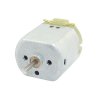Hi,
To say I'm new to electronics is an understatement! I have very very basic knowledge - my background is more mechanical and in high pressure pumps, but I want to make a device that requires some electronics. I hope you guys don't think my questions are too trivial! The answer might be obvious, and I hope it is, but it's out of my comfort zone. That said, I've been keen to learn some electronics for a while, especially as nearly everything contains something electronic these days.
Basically, I need to have a wheel that when prompted, turns through a very specific degree of rotation and stops until it receives the next instruction to turn. Each movement must be 1/17th of one full rotation, which I calculate to be 21.18 degrees. This is vital because the wheel will be divided into 17 sections and I don't want it to become misaligned over time. So my questions are;
A) Would I use a stepper motor or a servo?
There is no real weight to the wheel - think of it as being similar to a hamster wheel (except it lays horizontally) made from Acrylic, approx 110mm in diameter and 30mm in depth. It carries no imposed load, I simply have to turn the wheel by the exact increment, job done. The speed it turns would be inconsequential, but relatively slowly would be better I guess.
B) Do I use some kind of sensor / microswitch to stop at precisely 21.18 degrees, or maybe a microprocessor?
I'm already thinking of using an Arduino or Raspberry and a motor shield, because I also want to be able to activate it remotely via the interweb and therefore need it to talk to the modem nearby. I believe this is done with an Ethernet shield? I guess I'll sort through that problem in a different blog once I've sorted out how this wheel will actually operate?
So, thank you for your time and patience. I really hope some of you nice people can throw some light on this for me!
Cheers.
To say I'm new to electronics is an understatement! I have very very basic knowledge - my background is more mechanical and in high pressure pumps, but I want to make a device that requires some electronics. I hope you guys don't think my questions are too trivial! The answer might be obvious, and I hope it is, but it's out of my comfort zone. That said, I've been keen to learn some electronics for a while, especially as nearly everything contains something electronic these days.
Basically, I need to have a wheel that when prompted, turns through a very specific degree of rotation and stops until it receives the next instruction to turn. Each movement must be 1/17th of one full rotation, which I calculate to be 21.18 degrees. This is vital because the wheel will be divided into 17 sections and I don't want it to become misaligned over time. So my questions are;
A) Would I use a stepper motor or a servo?
There is no real weight to the wheel - think of it as being similar to a hamster wheel (except it lays horizontally) made from Acrylic, approx 110mm in diameter and 30mm in depth. It carries no imposed load, I simply have to turn the wheel by the exact increment, job done. The speed it turns would be inconsequential, but relatively slowly would be better I guess.
B) Do I use some kind of sensor / microswitch to stop at precisely 21.18 degrees, or maybe a microprocessor?
I'm already thinking of using an Arduino or Raspberry and a motor shield, because I also want to be able to activate it remotely via the interweb and therefore need it to talk to the modem nearby. I believe this is done with an Ethernet shield? I guess I'll sort through that problem in a different blog once I've sorted out how this wheel will actually operate?
So, thank you for your time and patience. I really hope some of you nice people can throw some light on this for me!
Cheers.




